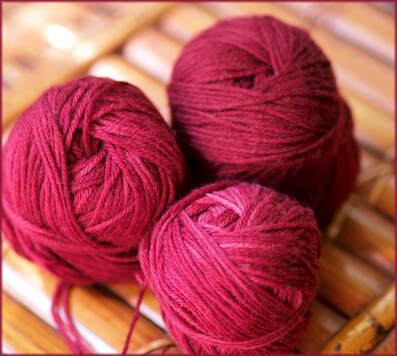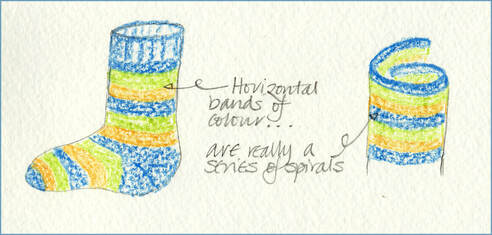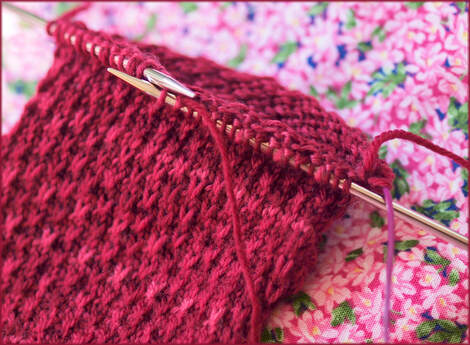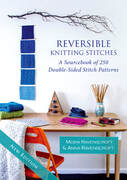I have been thinking about spirals recently, and how they are important in knitting. Sometimes they can be interesting, but they can also be a nuisance. For example, when we are trying to put bands of colour into a circular item such as a sweater or a bag, then we might see a “jog” at the colour join.
At first this is surprising because we tend to think we are working horizontal bands of colours, forming stripes. However, what we are actually knitting is a series of spirals.
At first this is surprising because we tend to think we are working horizontal bands of colours, forming stripes. However, what we are actually knitting is a series of spirals.
I was musing about this for a bit and then realised that we could actually use this to our advantage. After a bit of experimenting I saw that if you use three different colours of yarn spaced evenly around as you work, then different colours will appear as single-width stripes. Similarly if you used two balls of one colour and one ball of a contrast shade, you should see alternating thick and thin stripes.
I had recently received some wonderful kettle-dyed yarns from Knit Picks, their Stroll Tonal yarn. The photo at the top shows three balls of this yarn and what is perhaps surprising is that they are all from the same dye-lot.
They are all beautiful colours in themselves and with a wonderful depth and interest resulting from kettle-dyeing the yarn. However if I made a pair of socks, one with one ball, the second with another and the third ball being used as a back-up if I ran out of yarn along the way, then each sock would be very different.
One would be a glorious dark burgundy colour, with hardly a lighter patch in it. The other would have bright sparks of colour almost verging on light pink. Basically the socks would not look like a matched pair.
I had recently received some wonderful kettle-dyed yarns from Knit Picks, their Stroll Tonal yarn. The photo at the top shows three balls of this yarn and what is perhaps surprising is that they are all from the same dye-lot.
They are all beautiful colours in themselves and with a wonderful depth and interest resulting from kettle-dyeing the yarn. However if I made a pair of socks, one with one ball, the second with another and the third ball being used as a back-up if I ran out of yarn along the way, then each sock would be very different.
One would be a glorious dark burgundy colour, with hardly a lighter patch in it. The other would have bright sparks of colour almost verging on light pink. Basically the socks would not look like a matched pair.
So I started making my new pair of socks using all three balls of yarn in the same round. It was surprisingly easy to do and the colours just melded together, giving a far more harmonious final result. Of course there were still lighter-coloured stripes and highlighted stitches, but these are the feature of kettle-dyed yarns that draw us to them in the first place.
This technique also has another advantage and that is to break up the pooling or "Zebra-striping" that often occurs when using hand-dyed yarns. This is where splodges of colour end up in the same location round after round. Using several balls of yarn in the same round interrupts this unwanted patterning and lets the beauty of the yarn shine through. And of course, this could be useful not just for socks but in any garment where you are seeing this effect.
I will post more details about this new pattern, the Mentmore Socks, next time but if you'd like to read more now then please click here.
Until next time – Happy Sock Knitting!
Moira
This technique also has another advantage and that is to break up the pooling or "Zebra-striping" that often occurs when using hand-dyed yarns. This is where splodges of colour end up in the same location round after round. Using several balls of yarn in the same round interrupts this unwanted patterning and lets the beauty of the yarn shine through. And of course, this could be useful not just for socks but in any garment where you are seeing this effect.
I will post more details about this new pattern, the Mentmore Socks, next time but if you'd like to read more now then please click here.
Until next time – Happy Sock Knitting!
Moira
Last Blogpost: Bags of Bags! Next Up: Mentmore Socks Our book: Reversible Knitting Stitches My Website: www.wyndlestrawdesigns.com |
Keywords: Patterns/Accessories,
sock, socks, tonal yarns, space-dyed yarns, kettle-dyed yarns, blending yarns, dyelots, dye lots, hand-dyed yarns, zebra striping, colour pooling,
sock, socks, tonal yarns, space-dyed yarns, kettle-dyed yarns, blending yarns, dyelots, dye lots, hand-dyed yarns, zebra striping, colour pooling,



